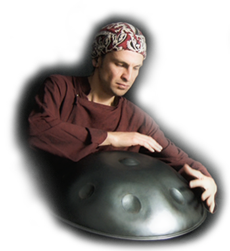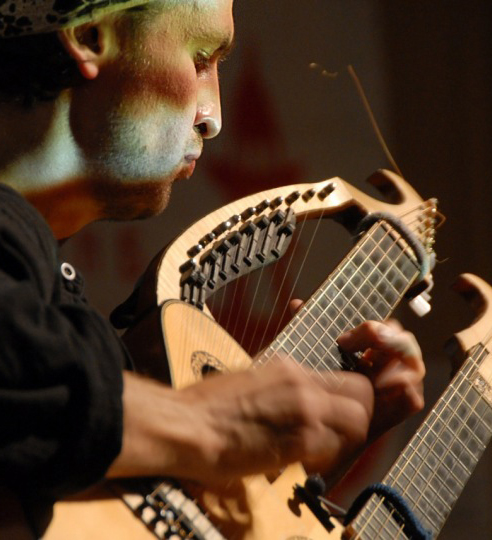| Interview for the WISP magazine |
 |
 |
 |
|
Nadishana has agreed to answer some of our questions for Wisp, here are a few notes from the interview (with our thanks to Tara Stewart.)
Nadishana, why are you so passionate about folk instruments? Because ethnic instruments have a potential which modern western instruments (mostly) doesn’t have any longer. Due to the evolution, those instruments became very “polished and clean” in many senses. They are very well optimized to play music in twelve tone equal temperated scale. Ancient ethnic instruments are “raw and unpolished” and mostly suitable to play wide range of ornamentations and timbre variations. If you know how to use their power you can touch special things in human beings, which you cannot access with modern familiar instruments. Ancient overtone instruments have direct access to some magic inside us. What I’m trying to do is to combine the power of those two kinds. It is a very challenging and interesting task. What role does trance state play on playing different types of instruments —e.g. strings as opposed to percussion or woodwind? Well I don’t know your definition of ‘trance state’, but let’s say for me ‘trance state’ means: having the control of your playing and in the same moment letting the sorcerous element of music express itself. This kind of state is not easy to achieve because it is the combination of a discipline and freedom (sounds like contradiction). Usually what I see around is just one of them. This is the aspect of music which you cannot learn. And as far as you have it, it doesn’t matter which type of instrument you’re playing: wind or stringed. What sort of feelings or energy differences do you get playing in nature as opposed to urban performance settings? As far as I am in a trance state as described above, it doesn’t really matter. What was the first music you remember? I consciously made this question hard to answer for myself. The first music I remember was some song which I heard from radio when I was a child. I did some things to forget it. So now I don’t remember it anymore.
Nadishana on the Ancient Kuzhebar Culture “…For ancient Kuzhebarans time was non linear, that’s why it is impossible to ascertain with exactitude, where is the beginning and the ending of their culture. It can be, that it was coming to us from the future… Some relics of this early civilization belong to the Mesozoic and the Palaeosoic, although contemporary science supposes there was no human race then. This paradox is assignable to the fact, that ancient kuzhebarans were able to create their own tunnels of reality, live in different worlds, epoches and places… ”
(Z.Puzdicustskuskst “Embryonal stages of development of the soul in the Ancient Kuzhebar’ culture”, P. 14, Publishing House “Area of Thought”, Ymambaba, 2001.)
What is “Kuzhebar”? • One of the tales says, that the name comes from the word “kuzhebor” (-bor means forest in Russian), a mythological forest, where protoplants were growing. There are more versions, but now it is impossible to say, which one is right, because ancient Kuzhebarans were able to create alternative tunnels of reality and had the ability to exist in many times and places simultaneously. Speaking about the Ancient Kuzhebar culture as being very old, is simply a convention. It means only, that the first artefacts, which were found in the small Siberian village Nizhny Kuzhebar, belong to an ancient period of history.
Could you explain us the basic principles of the Ancient Kuzhebar religion? • The Ancient Kuzhebar culture was steeped in the use of the Laugh. In Ancient Kuzhebar Humour and the Laugh were considered to be the most serious spiritual and psychic-energetic practice. One of those practices was called “The Yoga of Laughter”. Unlike in our culture, in Ancient Kuzhebar the laughter was not the antithesis of seriousness, but it was the part of it. There was even a separate caste “the monks of Laughter”.
The world of ghosts was well known in Ancient Kuzhebar, but ancient Kuzhebarans didn’t worship them like they do in other cultures. They considered them to be forces, representants of other dimensions with whom one could interact or ally. Man creates gods as gods creates man.
What was the Ancient Kuzhebaran view on death? • It depended on the way the person gave meaning to death. One prefers an absolute end, another takes a new body in body shop and some chose the deathless state. There were so called “Twenty Deathless’” in Kuzhebar as the result of the first genetic experiments of the Ancient Kuzhebar arch-father “Yagdyn Staroy”. These creatures are still alive and we have just detected two of them. Ancient kuzhebarans could transform in their consciousness sex, death, all phenomena and objects, impart them any meaning they wanted, depending on their intent.
Are there many people, who cultivate the Ancient Kuzhebar culture? • Not so many. May be we simply don’t know all of them. |







 Nadishana has agreed to answer some of our questions for Wisp, here are a few notes from the interview (with our thanks to Tara Stewart.)
Nadishana has agreed to answer some of our questions for Wisp, here are a few notes from the interview (with our thanks to Tara Stewart.) 
